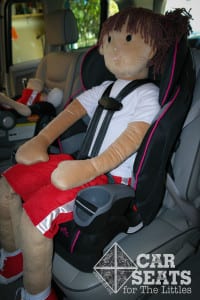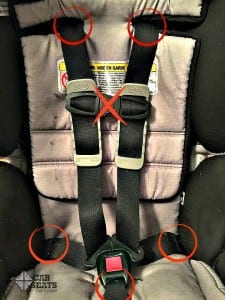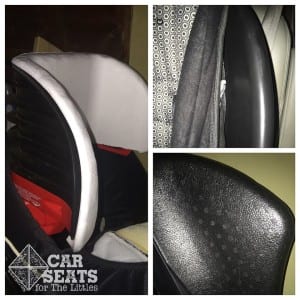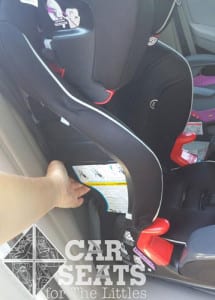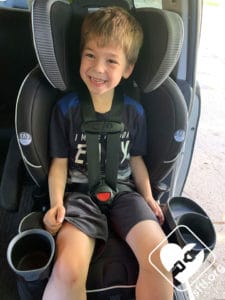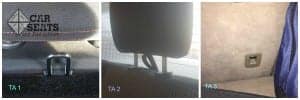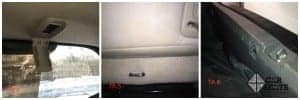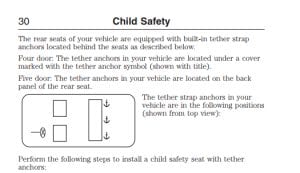By now, we hope it is common knowledge that children should face the rear of the vehicle for at least 2 years, but eventually kids do need to ride forward facing because they’ve outgrown their car seats in rear facing mode.
While many of us may remember leisurely flopping around the back seat as our parents drove us places, forward facing harnessed seats intended to protect the child in the event of a crash were first introduced by Leonard Rivkin of Colorado, and patented in 1962. 1 Before that invention, ‘child seats’ were merely containment or entertainment devices, with no particular crash worthiness.
Nine years later, in 1971, the federal government began regulating child passenger safety standards, and states began introducing child passenger safety laws. Today we have FMVSS 213, which specifies all standards for child passenger safety seats. It regulates aspects including head and knee excursion (how far the head and knees can travel in the event of a crash), likelihood of a head injury, and force on the chest, as well as multiple other aspects including labeling, containment, and padding. 2
Basics
The forward facing seat consists of a harness with five points of contact: one at each shoulder, one at each hip, and one between the thighs.
Car seats usually (but not always) have a hard exterior shell that’s made up of some combination of plastics or metals. In addition, many car seats have energy absorbing foam in the interior — either expanded polypropylene (EPP) or expanded polystyrene, aka, styrofoam (EPS) foam, similar to the foam found in bicycle helmets.
Your child’s seat may also have an adjustable head restraint. This type of harness adjusts easily, usually by squeezing a handle. For forward facing use, the harness is placed at or above the child’s shoulders then tightened to pass the pinch test.
Installation
The car seat itself is secured to the vehicle in one of two ways: with lower anchors if the seating position has them, and the child has not exceed the maximum allowed lower anchor weight limit or with the vehicle seatbelt. Either mechanism is passed through the forward facing belt path and locked in place.
A secure installation has less than one inch movement at the belt path, regardless of installation method. Learn more about checking for movement. The final step is securing the top tether connector to a tether anchor dedicated to that seating position.
Rear Facing vs. Forward Facing
In a rear facing car seat, both the harness and the shell of a child restraint work together to cradle and protect the child. Once a child moves from a rear to a forward facing seat, the shell of the seat no longer cradles the child during a crash. Now the harness alone must do the job of retaining the child. This means that the harness must be spread over the strongest points of the child’s body, and not on the weaker body parts like the child’s belly. While a rear facing only (infant) seat allows the ‘hip straps’ to ride near the belly, a convertible (rear facing to forward facing) forces the straps lower on the child’s hips and thighs.
In a rear facing seat, the hip straps serve more a goal of positioning the child in the center of the seat. In a forward facing seat, the hip strap position must force the harness along the pelvis rather than the abdominal organs.
What Happens in a Crash?
In the event of a crash, everything in the vehicle continues to move toward the point of impact until it is acted upon by another force. The car seat moves until the seatbelts stops stretching and holds it in place. Then, the child will continue to move beyond that point until the harness stops stretching and holds the child in place.
In addition, any part of the child’s body that is not restrained by the harness will travel even further (i.e, head and extremities) until they are stopped only because they’re attached to the child.
What the Car Seat Does
The child restraint performs two primary functions. It prevents the child from being ejected from the vehicle, and it prevents, ideally, the child from impacting anything within the vehicle. This is why excursion is such an important standard. A child whose head travels too far runs the risk of his head striking the interior of the vehicle, thus greatly increasing the risk of brain or spine injury.
For a forward facing child, harness tightness becomes especially crucial, with no room for error. Loose harness straps or a harness that’s compromised by bulky and non compressed winter wear work against the great forces involved in a crash and can result in the child being ejected from the vehicle.
Top Tether Purpose and Use
In the event of a crash, a child’s head and limbs will continue to travel further than his torso, which is restrained. The further a child’s head travels, the greater the risk of injury. A top tether can significantly limit the amount of this movement, by as much as four inches.3 Some back seats have limited space so four inches can make quite a difference!
By creating another point of contact on the seat, in addition to the point of contact created by the lower belt path, the entire seat, and thus, the entire occupant, is prevented from moving as far as it might.
All forward facing car seats sold in the United States and Canada have top tether connectors, but NOT all vehicles or vehicle seating positions have tether anchors. This divide can lead to some challenging situations when trying to safely seat multiple children in a vehicle.
In September 2000, Federal standards were updated to require that passenger vehicles with at least five seats have at least three seating positions in the rear that include with a top tether anchor. Some convertible vehicles and higher weight vehicles including heavy trucks are exempt from the standard. Most vehicles with a model year of 2001 and after have three tether anchor locations.
Unfortunately, higher occupancy vehicles including minivans and SUVs with a 3rd row are NOT required to have more than three tether anchors. This can lead to serious frustration for caregivers, and require some patience figuring out a safe seating configuration for all passengers.
Finding the Top Tether
Top tether anchors may be prominent and easy to find, or inconspicuous and difficult to locate. Here are a few common places to look:
- A standard five passenger sedan will likely have them displayed along the dash behind the head restraints.
- Vehicles with captain’s chairs may have them on the back of the seat, or the bottom of the seat.
- Certain SUVs hide them at the corner of the bottom of the back of the seat.
- Tether anchors are also found on the floor, in the ceiling, on the back dash, as fabric loops, or even doubling as cargo anchors.
Because top tether locations are so varied, it’s extremely important to read your vehicle’s manual to find out which seats have tether anchors, what they look like, where to find them, and how to use them.
Tether anchors are often, but not always, marked with a symbol that resembles an anchor being tossed overboard a ship.
Rear Facing to Booster Age?
Some caregivers may question why it is recommended to harness a child forward facing if there is risk of injury because of excursion. They may consider skipping the forward facing harness altogether and moving the child directly from a rear facing car seat to a booster. Depending on the age of the child when the switch is made, this may be a viable option. However, since children shouldn’t ride in boosters before they’re five years old, it may not be practical to rear face a child for that long. Others may simply be too young to handle the responsibility of a belt positioning booster when they outgrow their rear facing seats.
Is your Child Ready?
Harness or Booster: When to Make the Switch can help with the decision. A study done comparing the effectiveness of rear facing seats versus belt positioning boosters, in Sweden, where the use of a forward facing harness is discouraged and children move from the former stage to the latter with no interim step, may give us insight into why a forward facing harnessed seat may be needed for children too young for a booster alone.
The study found that 2-4 year olds in boosters experience significantly higher injury rates than their 7-10 year old peers in belt positioning boosters. Those injury rates in the age group were very low for children restrained in rear facing seats.4
While keeping a child rear facing to five and then moving to a belt positioning booster is certainly possible, many caregivers find that they need to move their child to a forward facing position sooner than five to six years of age. The forward facing harness is the best way to protect a child who is too young for a belt positioning booster. The Center for Disease Control found the evidence compelling enough as a public health issue to issue a recommended minimum age of 5 for booster usage.
Child Maturity and Booster Use
In addition to the concern for increased injury risk to younger booster users, consider the maturity and development of the child. Young children are not able to assess risk nor consistently follow commands in the way that older children are. Moving to a booster puts responsibility for the safety of the child out of the hands of a caregiver and into the hands of the child. Where a harness holds a child in the correct position pre-crash, a booster allows a child to choose to move out of position. Four year olds, and even many five year olds, simply cannot handle that sort of responsibility with consistency and reliability. While many children can handle a booster by six, some children will continue to benefit from even longer harnessed use.
In addition to the safety concerns, forward facing harnesses provided convenience benefits as well. If you have a small sedan with three children across, harnesses are simply easier to use than boosters. Digging for a seat belt buckle, or buckle stalk, between two seats can be nearly impossible.
Older Children and Special Situations
On longer trips or while sleeping, even older children may find a harness more comfortable and supportive, and less tiring than trying to intentionally remain in position the entire time.
Children with neurodevelopmental delays or physical conditions that lead to lowered muscle tone, often continue to benefit from a harness longer than children without these concerns.
While a forward facing harness may take up comparatively less time of a child’s restraint using days (rear facing for 2-4 years, and booster use for 3-5 years, compared to perhaps 2-3 for harnessed usage), it represents an important step in child passenger safety.
1. Rivkin, Leonard 1962 US2877833 A United States Patent and Trademark Office
2. Federal Motor Vehicle Safety Standard No. 213 Highlights of the Regulation for Child Restraint Systems. (2012, March 12). SafetyBeltSafe.
3. Whitman, G. R., Yannacone, J., Burton, J., & Shanahan, D. F. (2003). Occupant Kinematics with Child Safety Seats Tested Under Real World Conditions.Association for Advancement of Automotive Medicine.
4. Jakobsson, L., Isaksson-Hellman, I., & Lundell, B. (n.d.). Safety for the Growing Child -Experiences from Swedish Accident Data. Volvo Car Corporation Paper Number 05-0330. Retrieved February 15, 2016, from SAFETY FOR THE GROWING CHILD
– EXPERIENCES FROM SWEDISH ACCIDENT DATA

